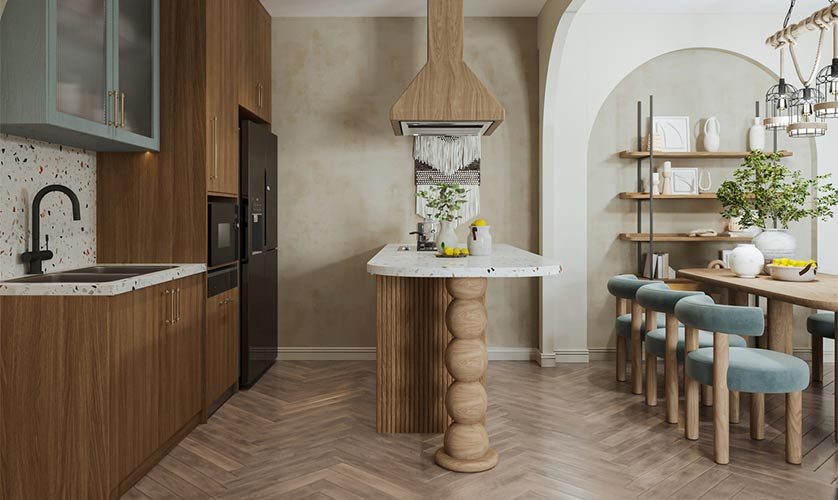
Mixing wood tones in home design has always been a topic ripe for discussion among homeowners and design enthusiasts in Reno, NV and beyond. The ability to blend different wood finishes within a space can elevate the aesthetic appeal and create a warm, engaging atmosphere. Whether it’s in your kitchen, bath, or throughout your home remodeler project with DreamMaker Bath & Kitchen of Reno, understanding how to harmoniously combine wood tones is key to achieving a cohesive and polished look. Let’s dive into some expert advice on how to master this skill.
Understand the Basics of Wood Tones
Before embarking on mixing wood tones, it’s essential to understand the basics. Wood tones can range from light to dark, each bringing its unique character to a space. One of the first steps is identifying the dominant wood tone in your room—this could be your hardwood floors, a large furniture piece, or even kitchen cabinetry. This dominant tone will serve as your anchor or reference point for adding in other wood elements.
Recognize the Importance of Undertones
Wood is not just about the surface color. The underlying tones can significantly impact how different woods look together. Woods with warm undertones tend to have hints of red, orange, or yellow, whereas cool-toned woods may lean towards gray, blue, or green hues. Recognizing these undertones is crucial for mixing wood tones effectively, as it helps create a nuanced and layered design without clashes. This kind of attention to detail is especially vital in interior remodeling projects, where harmony across materials defines the final look and feel of your space.
Create Contrast and Cohesion
Contrast is your friend when mixing wood tones, but it’s important to do so thoughtfully. Pairing a light wood with a significantly darker wood can add depth and visual interest to your space. However, ensuring some level of cohesion is crucial; this can be achieved by repeating a particular wood tone in different areas of the room for a sense of continuity. For example, if you have a dark walnut table, consider incorporating walnut accents in other parts of the room, such as picture frames or shelving.
Balance the Palette with Neutrals
When mixing multiple wood tones, using neutral colors in your overall palette can help tie everything together. Neutrals can act as a buffer, preventing the space from feeling overwhelming and allowing the beauty of the wood to shine through. In rooms with a more extensive mix of wood tones, consider using white, beige, or soft gray on the walls to provide a calm backdrop. A skilled general contractor can help coordinate these elements, ensuring that the mix of materials feels intentional and well-executed.
Incorporate Texture for Added Depth
Texture plays an essential role in mixing wood tones successfully. Different finishes, such as matte, gloss, or distressed, can add layers of interest to your space. Incorporating a variety of textures helps break up the monotony and can make even similar wood tones feel distinct and purposeful.
Embrace the Process
Remember, creating a space you love involves trial and error. Don’t be afraid to experiment with different combinations of wood tones and textures. What works in one space may not in another, and personal preference plays a significant role in determining the final result.
Let’s Start a Conversation!
If you’re embarking on a renovation project in Reno, NV, and need expert guidance on mixing wood tones or any other design element, DreamMaker Bath & Kitchen of Reno is here to help. Our team of design professionals is adept at creating beautiful, cohesive spaces that reflect your unique style. To get started, give us a call at (775) 522-7888 or fill out our online form. Let’s make your dream home a reality together. We also serve Sparks, Incline Village, Spanish Springs, Verdi, Truckee, Lake Tahoe, and Carson City.








